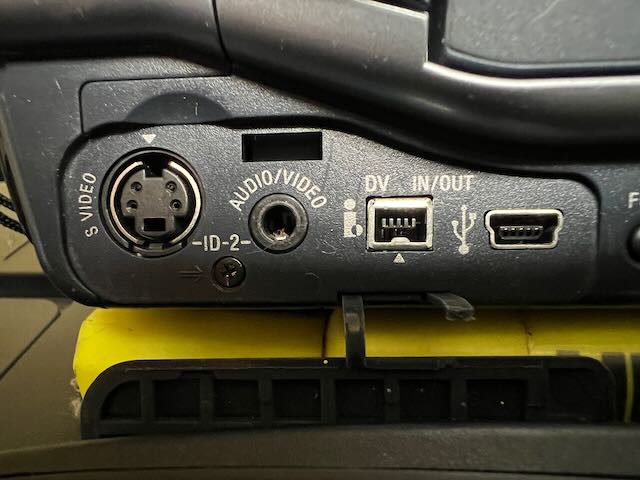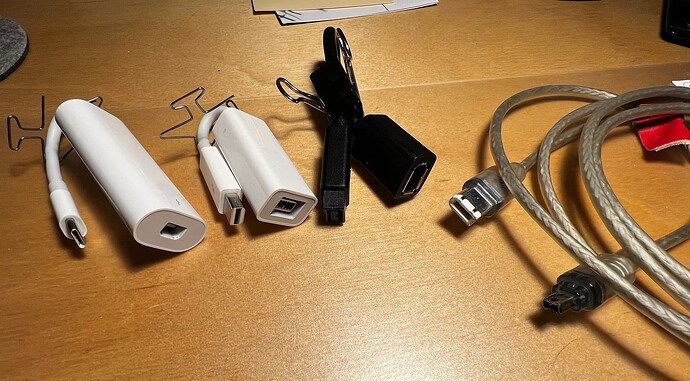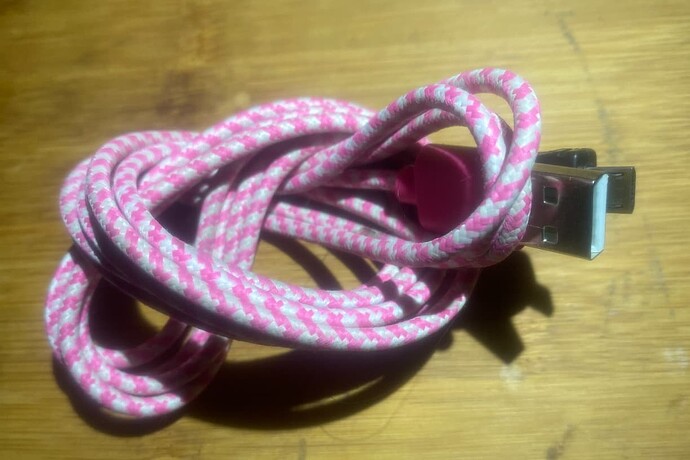I would do this with the very cameras if they could be connected with my Powerbook but they are not recognized. Is there a “simple” gadget that can just play back the tapes and has a port to connect an external drive? Or maybe there is another solution. I have an elgato video capture with red, yellow, white pins. But I do not know how to connect it to the cameras: iLink, hdv dv, HDMI out, component, A/V out are available but no adapters.
What ports are there on the camera? You could get a vhs player, but if you clean the camera heads and the camera has out ports, you may be able to connect it directly to the computer. Determine which camera ports give the best resolution and find a USB to Whatever-port. If the camera has its own digital out ports, that is even better. I have a RCA to USB converter that I use with recording software. The Sony camera may have thunderbolt or other digital out built in, just need the correct plug.
That’s where I’m stuck.
DV-based cameras (including mini DV and Digital8) typically have FireWire digital output (also known as IEEE 1394 or i.Link, the latter of which being a Sony-proprietary 4-pin variant that was somewhat popular, but doesn’t provide power to devices). Fortunately, standard cables/adapters should be available, because it was very popular in its day.
If you have an older Mac with a FireWire port, just get an appropriate cable and connect it. If you have a newer Mac, then you need to get a few adapters from Apple. You’ll need their Thunderbolt to FireWire adapter and a Thunderbolt 3 to Thunderbolt 2 adapter. This will give you a FireWire-800 interface (capable of delivering data, but not power). You will then need an appropriate cable to mate it with your camera.
Some cables that might be appropriate/necessary for connecting your camera to Apple’s Thunderbolt-FireWire adapter (no recommendations here, just the results of an Amazon search):
- FW800-FW800 cable: https://www.amazon.com/dp/B071KSLDJ8
- FW800-FW400 cable: https://www.amazon.com/dp/B00X65XHZG
- FW800-i.Link cable: https://www.amazon.com/dp/B002PRE7SM
Although I haven’t ever owned a camcorder, I have used this chain of adapters (TB3 – TB2 – FireWire 800 – FireWire 400) to connect old FireWire hard drives and an iSight camera to a modern Mac mini. It all worked great (but FaceTime was unable to get audio from the iSight). So I suspect it should work for you too.
I’m not sure what kind of software support Apple provides for this today. In the past, you could just run iMovie and it would detect a FireWire camcorder as a video input source. Tell iMovie to record and push play on the camera to capture everything (and for some cameras, you wouldn’t even have to push the play button because iMovie would send the command). It would proceed to capture video from the camera, creating clips for every clip in the camera (a new clip starting at each place where you pressed the stop button during the original recording). The captured clips will be in DV format, which Apple software like iMovie and FinalCut should support.
If iMovie no longer has this support, then hopefully there are some other ways to capture from a FireWire video source (perhaps with a third-party application). I don’t know of specific applications, but that is where I would start looking.
With respect to your Elgato device, those red/yellow/white connectors (I assume they’re RCA connectors) will carry analog standard-definition audio/video. Your camera can probably provide this (maybe requiring a proprietary cable that it probably shipped with), but you will get much better results going through FireWire. Most mini DV/Digital 8 cameras (I think) support HD resolutions (not necessarily 1080p, but definitely better than the 480i of standard-definition analog video). And even if your camera only supports SD, a digital transfer (over FireWire) will not create the losses that a conversion to analog and back to digital (via the Elgato device) will create.
i.Link is a type of FireWire. There are a lot of I.Link to USB cables
i.Link is FireWire 400. But with a Sony-proprietary 4-pin connector instead of the industry-standard 6-pin connector. Electrically, the only difference is that i.Link doesn’t carry power, so any connected camera must have its own power supply - it can’t draw power from the FireWire bus.
Adapters to connect it to standard FireWire ports are easy to get.
An adapter for USB? Don’t count on it. FireWire and USB are two radically different technologies - a simple cable can not magically make them compatible. Any i.Link-USB adapter is going to need to be a USB-based FireWire interface, which will not be cheap and will probably require device drivers.
I did see some cheap i.Link-USB cables on Amazon, but after reading reviews, they sound like scams to me. People are saying that they don’t actually work. Maybe Sony had some camcorders that could detect a USB connection and switch its interface, but if so, I’ve never seen any such thing.
That’s what friends are for —> problem solved.
Having gone through all the drawers in the neighborhood I came up with all the necessary adapters (3) and 1 firewirecable.
Thanks for putting me on the right track!
I successfully imported many years’ worth of camcorder videos long enough ago that I don’t exactly remember the process, but I’m pretty sure I ran an S/Video cable from my camcorder into an Elgato device, which output mp4 files via a USB connection to my Mac. After reading the discussion above, I’m now wondering if I might have gotten better resolution by using an iLink cable. Regardless, and in direct response to the OP’s question: Here’s an image of the output ports of my Sony Digital8 Handicam. Yours undoubtedly has similar options. You may need a different capture device if your Elgato device is limited to RGB inputs.
Yes - the rightmost port is the one I used.
You mean you tried to connect your camera directly to your Mac via USB? Yeah, that won’t work (afaik). You need a video capture device with an input option that matches at least one output option on your camera. For example, my Elgato device had both RGB inputs (which sounds like what you describe yours having), and an S/Video input (the round, multi-pin jack). So my setup was Camera > S/Video cable > Elgato device > USB cable > Mac. And then you run the Elgato software on the Mac to control the import.
Again, this was long ago. If I were to do it today, I might look for a video capture device that took a more high-fidelity input (originating from the iLink port on the camera), and of course whose software would run on a modern Mac.
And failing that, there are always service bureaus who do this conversion directly from your source tapes.
No video capture device was necessary.Just an iLink to Thunderbolt connection (thats where the 3 adapters are needed) and you’re good to go. Final Cut Pro recognises the new source.
Cool! Sorry for my bad memory. I should have read @Shamino’s posts more carefully. And I now see I also missed your “problem solved” post too. ![]()
If you could, would you mind listing the cables/adapters forming the chain from your camera (which sounds like it has the same outputs as mine) to your Mac? I might just have to try this (again) myself.
General observation: strive for the highest and best resolution transfer you can possibly get. We’re in a window where it is still possible to connect a MiniDV or Digital8 camcorder to a Mac with the right adapters and have it recognized as an input. It’s not hard to foresee a day when Apple deprecates and then drops support for the format because they no longer see a business case for maintaining the CODECs.
My parents had an early Sony digital camera that was capable of VGA-style images, but exported those images in lower resolution versions to save hard drive space. (It was a big consideration for them 25 years ago!) So, the digital remains we’ve been left with now that they’re gone are grainy thumbnails that can’t be enlarged.
If you have a choice of transfer modes, make it the very best available, and consider saving archival (unedited) versions of the raw footage on external media. Storage is cheap, and you’ll never be present for those scenes again.
In light of the measly quality of videos shot with early digital cameras I am just transferring those tapes into a format that is reasonably safe with respect to a “Best before date”. I have not used my Sony for quite a while, the iPhone 13 being the tool of choice for crisp videos of any desired length (with the added benefit of easy handling the results with iMovie or Final Cut Pro).
The picture above shows all necessary adapters and connections for transferals via iLink (Firewire) to M1 Thunderbolt.
Out of curiosity, what are the wire clips hanging off the two adapters on the left in your photo?
I was expecting this question :o)
Simple solution: in order to save the audience from examining several photos I tied the adapters in a way that both ports are visible. The wire clips were the first things in my drawer that looked like they could do the job.
Had luck with the same series of cable/adapter jumps (FW 4-pin to FW400 > FW400 to FW800 > FW800 to TB2 > TB2 to TB3 [USB-C]) and connected a couple Mini DV camcorders to a 2020 iMac running Catalina.
Unfortunately, the same old issue from the early 2000s came up as iMovie imports with far too many “clip” cut points, leaving us with a lot of partial shots needing to be stitched together, or in some cases, split. Additionally, I find iMove/macOS loses the beginning of many shots.
The stunning part is how these issues have not changed since Apple first added import support to iMovie on the Mac. There was a setting to disable clip separation on import but that was removed by Apple after iMovie 6 I think.
As I have not had time to do much in the last couple years, I am looking at tools like LosslessCut and ShotCut. Anyone have anecdotes on those or other free/open source tools? (Must not require internet connection).
I actually wind my cables similarly. I fold a cable in the middle so that the ends are next to each other, then I keep folding that in half, until I get something 7-12 inches long, which I then loop into a simple knot. The ends are visible together, making ID easy, and if I unloop the knot and hold the ends, the cable unfolds itself, tangle free.


